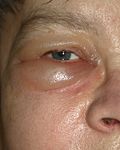Periorbital puffiness
Periorbital puffiness, also known as "puffy eyes" or swelling around the eyes, refers to the appearance of swelling in the tissues around the eyes, more specifically in the orbit, which is the cavity or socket of the skull in which the eye and its appendages are situated. This condition is common and can affect both adults and children. It is often temporary and can be a result of various factors including, but not limited to, lifestyle choices, medical conditions, and hereditary traits.
Causes[edit]
Periorbital puffiness can be caused by a wide range of factors:
- Sleep deprivation: Lack of sleep can lead to fluid buildup under the eyes, causing them to appear puffy.
- Fluid retention: This can be due to changes in weather, hormone levels, or consumption of salty foods.
- Allergies: Allergic reactions can trigger the release of histamines, which can cause inflammation and swelling around the eyes.
- Aging: As people age, the tissues and muscles supporting the eyelids weaken, leading to the accumulation of fluid in the lower eyelids.
- Medical conditions: Certain conditions such as thyroid diseases, infections, and skin disorders can lead to periorbital puffiness.
- Crying: The salt in tears can cause fluid retention in the eye area.
Symptoms[edit]
Symptoms of periorbital puffiness include:
- Swelling around the eyes
- Slight redness and/or itching
- Possible discomfort in the eye area
Treatment[edit]
Treatment for periorbital puffiness depends on its underlying cause. Some common treatments include:
- Cold compresses: Applying cold compresses can reduce swelling and inflammation.
- Antihistamines: If allergies are the cause, antihistamines can help reduce symptoms.
- Proper sleep: Ensuring adequate sleep can help reduce the appearance of puffiness.
- Salt intake reduction: Lowering salt consumption can decrease fluid retention.
- Elevating the head during sleep: This can prevent fluid from accumulating around the eyes overnight.
In cases where periorbital puffiness is persistent and accompanied by other symptoms, it is advisable to seek medical attention to rule out any underlying medical conditions.
Prevention[edit]
Preventive measures for periorbital puffiness include:
- Maintaining a healthy lifestyle with adequate sleep
- Managing allergies appropriately
- Reducing salt intake
- Using skincare products that are suitable for the sensitive skin around the eyes
See also[edit]
Ad. Transform your life with W8MD's Budget GLP-1 injections from $75


W8MD offers a medical weight loss program to lose weight in Philadelphia. Our physician-supervised medical weight loss provides:
- Weight loss injections in NYC (generic and brand names):
- Zepbound / Mounjaro, Wegovy / Ozempic, Saxenda
- Most insurances accepted or discounted self-pay rates. We will obtain insurance prior authorizations if needed.
- Generic GLP1 weight loss injections from $75 for the starting dose.
- Also offer prescription weight loss medications including Phentermine, Qsymia, Diethylpropion, Contrave etc.
NYC weight loss doctor appointmentsNYC weight loss doctor appointments
Start your NYC weight loss journey today at our NYC medical weight loss and Philadelphia medical weight loss clinics.
- Call 718-946-5500 to lose weight in NYC or for medical weight loss in Philadelphia 215-676-2334.
- Tags:NYC medical weight loss, Philadelphia lose weight Zepbound NYC, Budget GLP1 weight loss injections, Wegovy Philadelphia, Wegovy NYC, Philadelphia medical weight loss, Brookly weight loss and Wegovy NYC
|
WikiMD's Wellness Encyclopedia |
| Let Food Be Thy Medicine Medicine Thy Food - Hippocrates |
Medical Disclaimer: WikiMD is not a substitute for professional medical advice. The information on WikiMD is provided as an information resource only, may be incorrect, outdated or misleading, and is not to be used or relied on for any diagnostic or treatment purposes. Please consult your health care provider before making any healthcare decisions or for guidance about a specific medical condition. WikiMD expressly disclaims responsibility, and shall have no liability, for any damages, loss, injury, or liability whatsoever suffered as a result of your reliance on the information contained in this site. By visiting this site you agree to the foregoing terms and conditions, which may from time to time be changed or supplemented by WikiMD. If you do not agree to the foregoing terms and conditions, you should not enter or use this site. See full disclaimer.
Credits:Most images are courtesy of Wikimedia commons, and templates, categories Wikipedia, licensed under CC BY SA or similar.
Translate this page: - East Asian
中文,
日本,
한국어,
South Asian
हिन्दी,
தமிழ்,
తెలుగు,
Urdu,
ಕನ್ನಡ,
Southeast Asian
Indonesian,
Vietnamese,
Thai,
မြန်မာဘာသာ,
বাংলা
European
español,
Deutsch,
français,
Greek,
português do Brasil,
polski,
română,
русский,
Nederlands,
norsk,
svenska,
suomi,
Italian
Middle Eastern & African
عربى,
Turkish,
Persian,
Hebrew,
Afrikaans,
isiZulu,
Kiswahili,
Other
Bulgarian,
Hungarian,
Czech,
Swedish,
മലയാളം,
मराठी,
ਪੰਜਾਬੀ,
ગુજરાતી,
Portuguese,
Ukrainian


